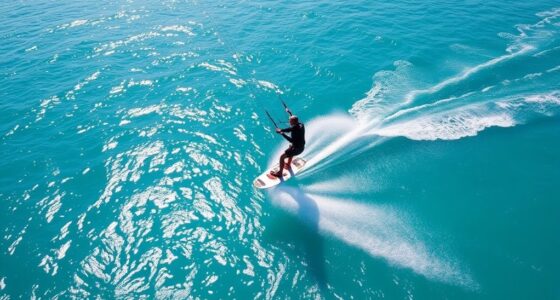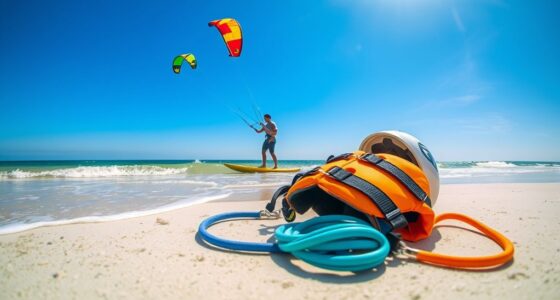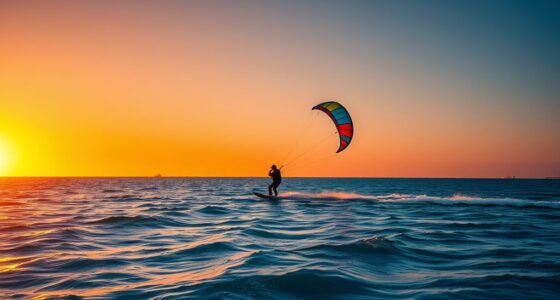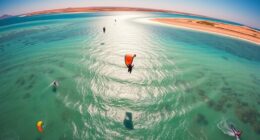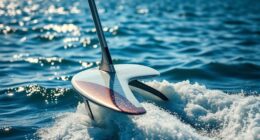To stay warm during cold-water kitefoiling, you need the right thermal layers and a high-quality wetsuit. Opt for a wetsuit with 4/3mm or 5/4mm neoprene, featuring sealed seams and good seals at the collar, wrists, and ankles to prevent water entry. Layering with thermal undergarments or insulated vests adds extra warmth, helping you stay comfortable longer. Keep exploring to discover more tips for staying warm and safe on the water.
Key Takeaways
- Use a high-quality 4/3mm or 5/4mm neoprene wetsuit with sealed seams for optimal insulation.
- Layer with thermal undergarments or rash guards underneath for extra warmth and moisture management.
- Consider adding neoprene vests or heated garments for prolonged cold-water sessions.
- Ensure proper fit to maximize insulation and prevent water entry, enhancing thermal efficiency.
- Combine wetsuit use with thermal accessories like gloves, hoods, and socks for comprehensive warmth.
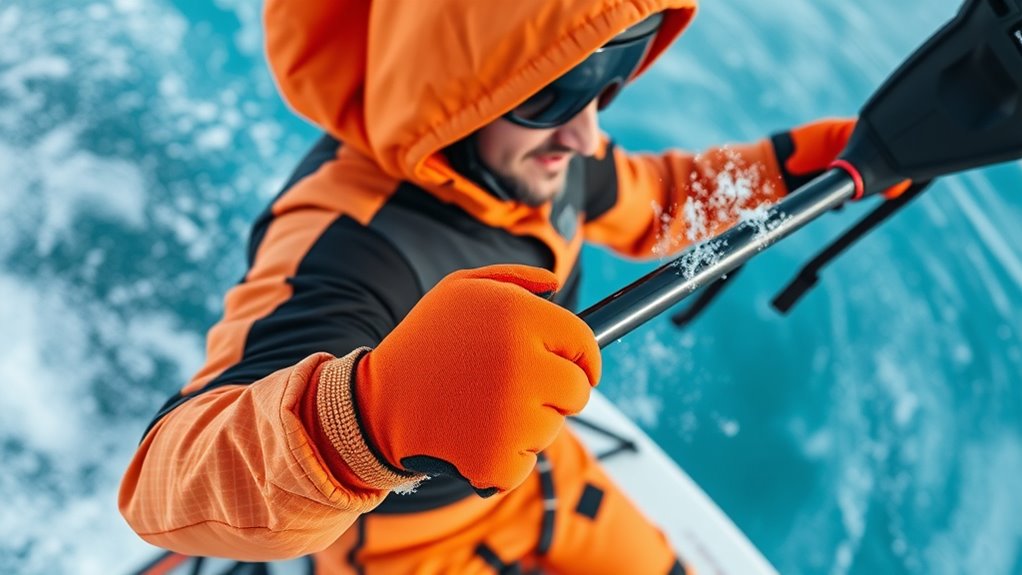
Cold-water kitefoiling offers an exhilarating experience, but it also demands proper preparation and gear to stay safe and comfortable. One of the most essential aspects of your gear is thermal insulation. When you’re out on the water in chilly conditions, maintaining body heat is paramount to prevent hypothermia and ensure you can enjoy your session without discomfort. The right thermal layers act as a barrier against the cold, helping you stay warm even when the water temperature drops considerably.
Wetsuit technology plays a key role in providing this thermal insulation. Modern wetsuits are crafted with advanced materials designed specifically to trap and retain body heat. Neoprene is still the primary material used, but innovations have improved its insulation properties and flexibility. For example, thicker neoprene panels around the torso help retain core warmth, while thinner, more flexible panels in the arms and legs give you better freedom of movement. Some wetsuits incorporate thermal lining, such as fleece or other insulating fabrics, which further enhances heat retention without adding bulk.
When selecting your wetsuit for cold-water kitefoiling, pay attention to thickness and sealing features. A wetsuit with 4/3mm or 5/4mm neoprene is typically recommended for colder waters, providing enough insulation to keep you warm during extended sessions. Sealed seams, such as those with glued and blind-stitched construction, prevent water from seeping in, drastically improving insulation. Additionally, a wetsuit with a high collar, wrist, and ankle seals helps minimize water entry, maintaining your body’s warmth more effectively.
Layering is also essential; consider wearing thermal undergarments or rash guards underneath your wetsuit for added insulation. Some kitefoilers opt for neoprene vests or heated garments designed with modern heating elements, which can markedly boost warmth during prolonged exposure to cold conditions. Remember, fit is critical—your wetsuit should be snug but not tight, ensuring maximum insulation without restricting movement or circulation.
Investing in quality wetsuit technology isn’t just about comfort; it’s about safety. Proper thermal insulation means you can stay out longer, focus on your riding, and reduce the risk of cold-related injuries. As you plan your cold-water kitefoiling adventures, prioritize high-performance wetsuits equipped with the latest thermal insulation features. This way, you’ll enjoy the thrill of the sport while keeping your body protected from the harsh elements. Additionally, understanding wetsuit materials can help you make more informed choices about your gear. With the right gear, you can confidently face colder waters, knowing your wetsuit technology has your back.
Frequently Asked Questions
What Are the Best Materials for Thermal Layers in Cold-Water Kitefoiling?
You should choose thermal layers made from neoprene fabrics and moisture-wicking materials for cold-water kitefoiling. Neoprene keeps you warm by trapping body heat, while moisture-wicking fabrics draw sweat away from your skin, preventing chills. Opt for a combination of these materials to stay dry and insulated during your ride. This guarantees comfort, warmth, and improved performance in cold conditions, helping you enjoy your session safely and effectively.
How Do Thermal Layers Affect Kitefoiling Performance and Safety?
Thermal layers directly impact your kitefoiling performance and safety by providing essential thermal insulation, keeping your body warm in cold water conditions. Good thermal layers also improve moisture management, preventing sweat from cooling your skin and causing discomfort or hypothermia. When you wear proper thermal insulation, you’ll stay more focused and agile, reducing the risk of accidents. Proper thermal layering ensures you enjoy your session safely while maintaining ideal performance.
Can Thermal Layers Be Layered for Extreme Cold Conditions?
Yes, you can layer thermal insulation for extreme cold conditions by using effective layering strategies. Start with a moisture-wicking base layer to keep sweat away. Add insulating layers like fleece or down for warmth, and top with a waterproof shell to protect from wind and water. This layering approach traps heat, maintains dryness, and enhances safety, ensuring you stay warm and perform well even in the coldest conditions.
How Often Should Thermal Layers Be Replaced or Upgraded?
You should replace or upgrade your thermal layers based on your maintenance schedule and signs of wear, like thinning or loss of insulation. Regular inspections help guarantee peak warmth and performance. Considering environmental impact, opt for durable, eco-friendly materials that last longer, reducing waste. Upgrading periodically also prevents you from relying on ineffective gear, keeping you comfortable and safe in cold conditions while minimizing your ecological footprint.
Are There Specific Brands Known for Effective Cold-Water Thermal Gear?
Imagine slipping into a thermal layer that feels like a second skin, keeping you warm amid icy waters. When choosing brands, focus on reputation and customer reviews, as these reveal reliable performance. Brands like Helly Hansen, Patagonia, and Xcel are renowned for their effective cold-water thermal gear. You’ll find many enthusiasts praising their durability, warmth, and comfort, making them top choices for cold-water kitefoiling adventures.
Conclusion
As you venture into cold-water kitefoiling, think of the thermal layers as your suit of armor against the icy waves. Mastering these layers keeps you warm and agile, turning chilly challenges into your playground. With each glide, you’ll feel like a swift fish slicing through the frosty depths, confident and unstoppable. Embrace these layers, and let them be your secret weapon in conquering the cold, riding the waves with fiery passion and icy precision.



